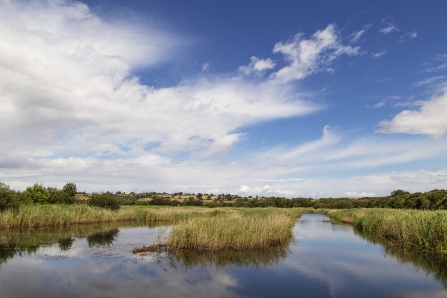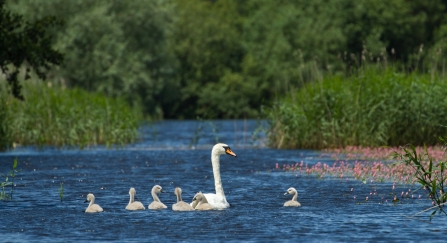In this 'info-blog' (we couldn't decide if it was an information sheet or blog!) we wanted to bring together some information about the key issues, with a bit of commentary to give you an overview of the situation, what it means for our work, and what perhaps you might be able to do to help bring about change - and to help make our waterways wonderful again. It's a really urgent issue for the county and nationally, so we hope you find it an interesting read - we'll be back with updates throughout the coming year.
For Somerset Wildlife Trust, water quality is of ongoing concern across the county, but never more so than for the land we manage on the Somerset Levels & Moors
It might look natural, but the Levels and Moors are a completely human-engineered landscape with a complex ditch and river system tightly controlled for water levels to allow for farming activity and to deliver flood protection in low-lying villages.
Waking up to water quality

Westhay Moor - Paul Eaton
Our Westhay Moor NNR is a haven for wildlife including a huge variety of water specialists such as bittern, european eel, great white egret, dragonflies, otters and the insectivorous sundew. It is one of many Sites of Special Scientific Interest (SSSIs) on the Somerset Levels & Moors - sites that are recognised for their special features for wildlife, geology and/or landform. Read more on SSSI responsibilities.
This designation gives them protection through the Wildlife and Countryside Act and means they must be kept in good condition. The government is responsible for ensuring this happens and ensures landowners manage their SSSI land to protect and conserve the SSSI features.
Together these SSSIs make up the Special Protection Area (SPA), designated by law as areas protected for bird species - in Somerset these include wigeon, teal, lapwing, snipe and bittern. They also form part of the Somerset Levels & Moors RAMSAR site, recognised as a wetland of international importance containing rare and unique wetland species.

Four-spotted chaser {Libellula quadrimaculata} dragonfly on Somerset Levels- Ross Hoddinott
In May, Natural England told us that, due to poor water quality, they were changing the condition status of all the Somerset Levels and Moors SSSI, including the nature reserves we manage to ‘Unfavourable – declining’ (worst status before ‘destroyed’), along with all other SSSIs. Their monitoring work, along with Wessex Water and the Environment Agency, showed Phosphate inputs at least 3 times the target. You can read the detail here: Natural England’s Briefing Note
The assessment concludes with this sentence “Whilst clear cause and effect relationships have yet to be established it seems entirely feasible that the excessive nutrients, combined with climate change, could lead to a situation where it is far more difficult, if not impossible, to maintain the supporting habitats of these bird species.”
So what does this actually mean for wildlife?
Nutrients (phosphorous, nitrogen and potassium) are essential for plant growth and are found at balanced levels in healthy soils. On the Levels and Moors nutrient loads are too high which has resulted in the huge growth of plant species (duckweed and algae) on the water surface of the ditch systems on the Levels. This blocks out sunlight killing other aquatic plant species, preventing photosynthesis and reducing oxygen levels in the water.
These conditions cause a significant decrease in the biodiversity of the water courses killing invertebrates and fish that require oxygenated water. In turn, the birds that feed on these species will most likely lose their food source.

Somersel Levels - Paul Harris/2020VISION
Why has this happened?
There's not one single cause or source of this pollution. For far too long we have failed to recognise the value of our water courses, and the importance of protecting them, instead treating them as a glorified rubbish bin for chemicals - fertilizers, washing detergents and other pollutants, human and animal waste, and more.
The Environment Agency released figures in 2020 showing that only 14% of English rivers are of good ecological standard and none reached good chemical status. For more on this we recommend you watch the Rivercide documentary.
There are three key areas that are contributing to the poor water quality on the Somerset Levels and nationally. For an in-depth look at the causes do read the blog post by Tony Whitehead at RSPB on West Country Bylines.
It is important to say that the sources of nutrient pollution mainly come from the surrounding river catchments, not just from the management of the SSSIs. (A river catchment is an area of land where water collects when it rains, often bounded by hills, and flows into streams, through soil and eventually into a particular river.) River catchments on the Somerset Levels are the Brue, Axe, Parrett, and Tone. Find out more on FWAG SW Catchment website.
What are the solutions?
Just as there are multiple causes of the poor water quality and high phosphate load in the Somerset Levels water courses, a range of solutions are required. Some are known and are already being put in place. Others are yet to be devised.

Mute swan and cygnets at Westhay Moor SWT reserve, Somerset Levels, Somerset, England, UK - Guy Edwardes/2020VISION
The large reduction in funding over the past decade to statutory bodies Natural England and the Environment Agency, which have essential roles in monitoring and enforcing these requirements and the requirements of the Water Framework Directive designed to improve water quality, has helped allow this situation to develop. Proper funding of these agencies is essential if water quality of all our rivers, including on the Somerset Levels, is to improve.
Landowners of SSSIs and land within the catchment must comply with all the requirements on them to deliver improved water quality . Breaches need to be identified and this needs to be enforced with penalties imposed. They may need advice and support to do this including whole farm finance advice to enable them to fund the measures they need to deliver.
Good land management practices such as the use of cover crops and buffer strips, reduced use of fertilizers and careful management of slurry and livestock can also play a vital role.
With the changes coming to the agri-environment subsidies and the introduction of the new Environmental Land Management Schemes, land owners must be incentivised to go beyond legal compliance by delivering natural solutions to improve water quality, which could include creation of wetland / reed bed habitat or flood plain that can slow or hold water that can break down nutrients into the soils and prevent them entering the water course.
Phosphate removal is difficult. It takes time - probably up to 80 years, but reductions may be achieved in shorter timescales by storing water in soils for longer allowing phosphates to be absorbed into the soils and broken down, or allowing water to flow through reed beds that suck out phosphates as the water passes through.
The Government has announced it will review the Habitat Regulations, the legislative framework for all these designations. It is essential that they are strengthened, not weakened, with proper resource for government agencies to be able to enforce these regulations.
In August 2020 Natural England wrote to all Somerset planning authorities advising them that the unfavourable water condition of the Ramsar site should be given ‘due consideration’ before granting planning applications based on recent caselaw known as the ‘Dutch Nitrogen’ case (legal summary here). The result of this requires all new developments to demonstrate ‘phosphate neutrality’ to avoid increasing the phosphate load within the Ramsar.
Wessex Water must play an important role in preventing sewage discharges into water courses. They have committed £57m by 2024 towards this, but will need to be held to account to do more if it isn’t enough.
What can you do?
- Think very carefully about what goes into your toilet or down your plug hole. Find out more about the Three Ps here. Fats, oils and greases here.
- Check your home for misconnections and sort them out, some advice here.
- Make sure your cleaning products are phosphate free.
- Report pollution incidents immediately to the Environment Agency 0800 80 70 60 or Wessex Water 0345 600 4 600 (who will also inform the EA). Signs of pollution can include a sewage smell, dead or gasping fish, cloudy water or items like toilet paper and wipes.
- Support local farmers who are reducing fertilizer use and actively improving soil health.
- Hold the government to account by writing to your MP and DEFRA asking for the Habitat Regulations review to ensure water quality requirements are strengthened and enforced with sufficient funding for statutory agencies; and to support farmers to manage their land differently to improve soil health, water quality and all the biodiversity benefits that brings.
Write your own letter of supporter with the template below.
What we will do?
- With The Wildlife Trusts nationally, call for strong legislation through the Habitat Review to improve water quality, and for landowners to be incentivised to manage their land reducing nutrients and removing them from the catchment
- Call for existing laws to be followed with funded, stronger enforcement mechanisms for those who pollute, whether landowners, businesses, individuals, developers or water companies.
- Manage our sites without increasing the phosphate load and look for opportunities to remove phosphates from the system through our land management.
- Continue to work with communities to promote wider understanding of the challenges facing our wetlands and waterways, from source to sea – including expanding our Water Guardian volunteer programme in partnership with Wessex Water. Water Guardians are volunteers who are trained to spot and report pollutions, monitor key indicators of water quality such as phosphates and litter pick along their local stretch of river.




